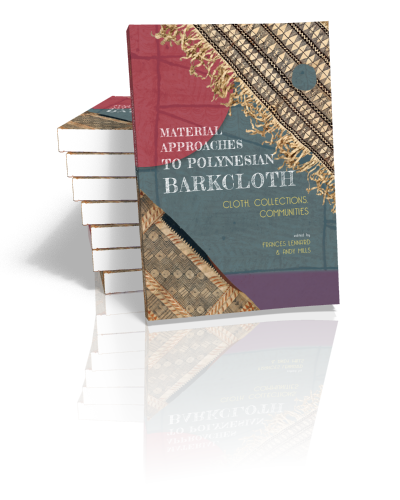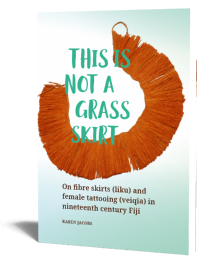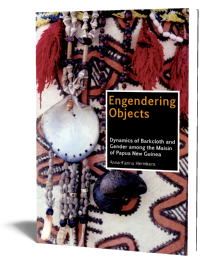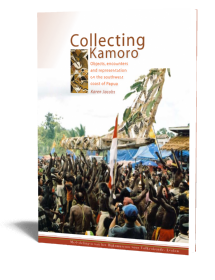Material Approaches to Polynesian Barkcloth
Cloth, Collections, Communities
Edited by Frances Lennard & Andy Mills | 2020

Material Approaches to Polynesian Barkcloth
Cloth, Collections, Communities
Edited by Frances Lennard & Andy Mills | 2020
Paperback ISBN: 9789088909719 | Hardback ISBN: 9789088909726 | Imprint: Sidestone Press Academics | Format: 182x257mm | 342 pp. | Language: English | 143 illus. (fc) | Keywords: barkcloth; tapa; Polynesia; fibres; colourants; Pacific art; conservation; ethnobotany; material culture; collecting | download cover
Read online or downloaded 2753 times
-
Digital & Online access
This is a full Open Access publication, click below to buy in print, browse, or download for free.
-
Buy via Sidestone (EU & UK)
-
Buy via our Distributors (WORLD)
For non-EU or UK destinations you can buy our books via our international distributors. Although prices may vary this will ensure speedy delivery and reduction in shipping costs or import tax. But you can also order with us directly via the module above.
UK international distributor
USA international distributor
-
Bookinfo
Paperback ISBN: 9789088909719 | Hardback ISBN: 9789088909726 | Imprint: Sidestone Press Academics | Format: 182x257mm | 342 pp. | Language: English | 143 illus. (fc) | Keywords: barkcloth; tapa; Polynesia; fibres; colourants; Pacific art; conservation; ethnobotany; material culture; collecting | download cover
Read online or downloaded 2753 times

We will plant a tree for each order containing a paperback or hardback book via OneTreePlanted.org.
Barkcloth or tapa, a cloth made from the inner bark of trees, was widely used in place of woven cloth in the Pacific islands until the 19th century. A ubiquitous material, it was integral to the lives of islanders and used for clothing, furnishings and ritual artefacts. Material Approaches to Polynesian Barkcloth takes a new approach to the study of the history of this region through its barkcloth heritage, focusing on the plants themselves and surviving objects in historic collections. This object-focused approach has filled gaps in our understanding of the production and use of this material through an investigation of this unique fabric’s physical properties, transformation during manufacture and the regional history of its development in the 18th and 19th centuries.
The book is the outcome of a research project which focused on three important collections of barkcloth at The Hunterian, University of Glasgow; Royal Botanic Gardens, Kew and the National Museum of Natural History, Smithsonian Institution. It also looks more widely at the value of barkcloth artefacts in museum collections for enhancing both contemporary practice and a wider appreciation of this remarkable fabric. The contributors include academics, curators, conservators and makers of barkcloth from Oceania and beyond, in an interdisciplinary study which draws together insights from object-based and textual reseach, fieldwork and tapa making, and information on the plants used to make fibres and colourants.
This book will be of interest to tapa makers, museum professionals including curators and conservators; academics and students in the fields of anthropology, museum studies and conservation; museum visitors and anyone interested in finding out more about barkcloth.
Acknowledgements
Image credits
Biographies
Introduction
Frances Lennard
Part I: Tapa as Fabric: Bast and Colourants
The procurement, cultural value and fabric characteristics of Polynesian tapa species
Andy Mills
Plant profile 1. Paper mulberry, Broussonetia papyrifera
Plant profile 2. Breadfruit, Artocarpus altilis
Mark Nesbitt
Technical variation in historical Polynesian tapa manufacture
Andy Mills
Breadfruit tapa: not always second best
Michele Austin Dennehy, Jean Chapman Mason, Adrienne L. Kaeppler
Plant profile 3. Pacific banyan, Ficus prolixa
Plant profile 4. Māmaki, Pipturus albidus
Mark Nesbitt
A new perspective on understanding Hawaiian kapa-making
Lisa Schattenburg-Raymond
Polynesian tapa colourants
Andy Mills, Taoi Nooroa, Allan Tuara
Plant profile 5. Beach hibiscus, Sea hibiscus, Hibiscus tiliaceus
Plant profile 6. ‘Ākia, Wikstroemia uva-ursi
Mark Nesbitt
Hawaiian dyes and kapa pigments: a modern perspective and brief analysis of the historic record
Lisa Schattenburg-Raymond
Part II: Understanding Tapa in Time and Place
Towards a regional chronology of Polynesian barkcloth manufacture
Andy Mills
Living with tapa and the social life of ritual objects
Adrienne L. Kaeppler
Plant profile 7. ‘Oloa, Neraudia melastomifolia
Plant profile 8. Polynesian arrowroot, Tacca leontopetaloides
Mark Nesbitt
West Polynesian dyes and decorations as cultural signatures
Adrienne L. Kaeppler
‘A classification of Tongan ngatu’: change and stability in Tongan barkcloth forms since 1963
Billie Lythberg
White for purity, brown for beautiful like us and black because it is awesome
Fanny Wonu Veys
Plant profile 9. Koka, Bischofia javanica
Plant profile 10. Candlenut, Aleurites moluccana
Mark Nesbitt
Barkcloth from the islands of Wallis (‘Uvea) and Futuna
Hélène Guiot
Barkcloth in the Māori world
Patricia Te Arapo Wallace
‘Ahu Sistas: reclaiming history, telling our stories
Pauline Reynolds, Jean Clarkson
Plant profile 11. Turmeric, Curcuma longa
Plant profile 12. Noni, Morinda citrifolia
Mark Nesbitt
‘Tataki ʻe he Leá: Guided Language’
Tui Emma Gillies, Sulieti Fieme’a Burrows
Part III: Tapa in Collections and the Community
The Hunterian’s Polynesian barkcloth collection
Andy Mills
From maker to museum: Polynesian barkcloth at the Royal Botanic Gardens, Kew
Mark Nesbitt, Brittany Curtis, Andy Mills
Plant profile 13. Mati, Ficus tinctoria
Plant profile 14. Tou, Cordia subcordata
Plant profile 15. Ironwood, Casuarina equisetifolia
Mark Nesbitt
Smithsonian Institution barkcloth collections
Adrienne L. Kaeppler
‘Holomua ka hana kapa’: a symposium on caring for kapa and kapa makers at the Bernice Pauahi Bishop Museum, December 2017
Alice Christophe
Fiji masi and the Auckland Museum Pacific Collection Access Project
Fuli Pereira, Leone Samu-Tui
Plant profile 16. Malay apple, Syzygium malaccense
Plant profile 17. Red mangrove, Rhizophora mangle
Mark Nesbitt
Shown to full advantage: conservation and mounting of barkcloth for display in the ‘Shifting Patterns: Pacific Barkcloth Clothing’ exhibition at the British Museum
Monique Pullan
Conservation as part of ‘Situating Pacific Barkcloth in Time and Place’: improving preservation, enhancing access and sharing knowledge
Frances Lennard, Reggie Meredith Fitiao, Su’a Tupuola Uilisone Fitiao, Ruby Antonowicz-Behnan, Beth Knight
Afterword: Polynesian barkcloth past, present, future
Mark Nesbitt, Frances Lennard and Andy Mills
Bibliography

Prof. Frances Lennard
Frances Lennard is Professor of Textile Conservation at the University of Glasgow and was director of the Centre for Textile Conservation and Technical Art History until 2020. Her research interests focus on conservation approaches and methodologies and she is particularly interested in interdisciplinary research. She is the co-editor of Tapestry Conservation: Principles and Practice, with Maria Hayward and Textile Conservation: Advances in Practice, with Patricia Ewer. She was Principal Investigator of the research project, Situating Pacific Barkcloth in Time and Place.

Dr. Andy Mills
Andy Mills is curator for Archaeology and World Cultures at The Hunterian. He is a world art historian, ethnohistorian and anthropologist, with specialist interests in Oceanic art, collections provenance, missionary collecting, textiles, and arms and armour, among other things; he is the co-editor, with Tom Crowley, of Weapons, Culture and the Anthropology Museum. During the project Situating Pacific Barkcloth in Time and Place, Andy’s research focused on historical change in the arts of Polynesian barkcloth, analysing the materials and processes of tapa-making, and exploring the histories of barkcloth in the world’s museums.
Abstract:
Barkcloth or tapa, a cloth made from the inner bark of trees, was widely used in place of woven cloth in the Pacific islands until the 19th century. A ubiquitous material, it was integral to the lives of islanders and used for clothing, furnishings and ritual artefacts. Material Approaches to Polynesian Barkcloth takes a new approach to the study of the history of this region through its barkcloth heritage, focusing on the plants themselves and surviving objects in historic collections. This object-focused approach has filled gaps in our understanding of the production and use of this material through an investigation of this unique fabric’s physical properties, transformation during manufacture and the regional history of its development in the 18th and 19th centuries.
The book is the outcome of a research project which focused on three important collections of barkcloth at The Hunterian, University of Glasgow; Royal Botanic Gardens, Kew and the National Museum of Natural History, Smithsonian Institution. It also looks more widely at the value of barkcloth artefacts in museum collections for enhancing both contemporary practice and a wider appreciation of this remarkable fabric. The contributors include academics, curators, conservators and makers of barkcloth from Oceania and beyond, in an interdisciplinary study which draws together insights from object-based and textual reseach, fieldwork and tapa making, and information on the plants used to make fibres and colourants.
This book will be of interest to tapa makers, museum professionals including curators and conservators; academics and students in the fields of anthropology, museum studies and conservation; museum visitors and anyone interested in finding out more about barkcloth.
Contents
Acknowledgements
Image credits
Biographies
Introduction
Frances Lennard
Part I: Tapa as Fabric: Bast and Colourants
The procurement, cultural value and fabric characteristics of Polynesian tapa species
Andy Mills
Plant profile 1. Paper mulberry, Broussonetia papyrifera
Plant profile 2. Breadfruit, Artocarpus altilis
Mark Nesbitt
Technical variation in historical Polynesian tapa manufacture
Andy Mills
Breadfruit tapa: not always second best
Michele Austin Dennehy, Jean Chapman Mason, Adrienne L. Kaeppler
Plant profile 3. Pacific banyan, Ficus prolixa
Plant profile 4. Māmaki, Pipturus albidus
Mark Nesbitt
A new perspective on understanding Hawaiian kapa-making
Lisa Schattenburg-Raymond
Polynesian tapa colourants
Andy Mills, Taoi Nooroa, Allan Tuara
Plant profile 5. Beach hibiscus, Sea hibiscus, Hibiscus tiliaceus
Plant profile 6. ‘Ākia, Wikstroemia uva-ursi
Mark Nesbitt
Hawaiian dyes and kapa pigments: a modern perspective and brief analysis of the historic record
Lisa Schattenburg-Raymond
Part II: Understanding Tapa in Time and Place
Towards a regional chronology of Polynesian barkcloth manufacture
Andy Mills
Living with tapa and the social life of ritual objects
Adrienne L. Kaeppler
Plant profile 7. ‘Oloa, Neraudia melastomifolia
Plant profile 8. Polynesian arrowroot, Tacca leontopetaloides
Mark Nesbitt
West Polynesian dyes and decorations as cultural signatures
Adrienne L. Kaeppler
‘A classification of Tongan ngatu’: change and stability in Tongan barkcloth forms since 1963
Billie Lythberg
White for purity, brown for beautiful like us and black because it is awesome
Fanny Wonu Veys
Plant profile 9. Koka, Bischofia javanica
Plant profile 10. Candlenut, Aleurites moluccana
Mark Nesbitt
Barkcloth from the islands of Wallis (‘Uvea) and Futuna
Hélène Guiot
Barkcloth in the Māori world
Patricia Te Arapo Wallace
‘Ahu Sistas: reclaiming history, telling our stories
Pauline Reynolds, Jean Clarkson
Plant profile 11. Turmeric, Curcuma longa
Plant profile 12. Noni, Morinda citrifolia
Mark Nesbitt
‘Tataki ʻe he Leá: Guided Language’
Tui Emma Gillies, Sulieti Fieme’a Burrows
Part III: Tapa in Collections and the Community
The Hunterian’s Polynesian barkcloth collection
Andy Mills
From maker to museum: Polynesian barkcloth at the Royal Botanic Gardens, Kew
Mark Nesbitt, Brittany Curtis, Andy Mills
Plant profile 13. Mati, Ficus tinctoria
Plant profile 14. Tou, Cordia subcordata
Plant profile 15. Ironwood, Casuarina equisetifolia
Mark Nesbitt
Smithsonian Institution barkcloth collections
Adrienne L. Kaeppler
‘Holomua ka hana kapa’: a symposium on caring for kapa and kapa makers at the Bernice Pauahi Bishop Museum, December 2017
Alice Christophe
Fiji masi and the Auckland Museum Pacific Collection Access Project
Fuli Pereira, Leone Samu-Tui
Plant profile 16. Malay apple, Syzygium malaccense
Plant profile 17. Red mangrove, Rhizophora mangle
Mark Nesbitt
Shown to full advantage: conservation and mounting of barkcloth for display in the ‘Shifting Patterns: Pacific Barkcloth Clothing’ exhibition at the British Museum
Monique Pullan
Conservation as part of ‘Situating Pacific Barkcloth in Time and Place’: improving preservation, enhancing access and sharing knowledge
Frances Lennard, Reggie Meredith Fitiao, Su’a Tupuola Uilisone Fitiao, Ruby Antonowicz-Behnan, Beth Knight
Afterword: Polynesian barkcloth past, present, future
Mark Nesbitt, Frances Lennard and Andy Mills
Bibliography

Prof. Frances Lennard
Frances Lennard is Professor of Textile Conservation at the University of Glasgow and was director of the Centre for Textile Conservation and Technical Art History until 2020. Her research interests focus on conservation approaches and methodologies and she is particularly interested in interdisciplinary research. She is the co-editor of Tapestry Conservation: Principles and Practice, with Maria Hayward and Textile Conservation: Advances in Practice, with Patricia Ewer. She was Principal Investigator of the research project, Situating Pacific Barkcloth in Time and Place.

Dr. Andy Mills
Andy Mills is curator for Archaeology and World Cultures at The Hunterian. He is a world art historian, ethnohistorian and anthropologist, with specialist interests in Oceanic art, collections provenance, missionary collecting, textiles, and arms and armour, among other things; he is the co-editor, with Tom Crowley, of Weapons, Culture and the Anthropology Museum. During the project Situating Pacific Barkcloth in Time and Place, Andy’s research focused on historical change in the arts of Polynesian barkcloth, analysing the materials and processes of tapa-making, and exploring the histories of barkcloth in the world’s museums.
-
Digital & Online access
This is a full Open Access publication, click below to buy in print, browse, or download for free.
-
Buy via Sidestone (EU & UK)
-
Buy via our Distributors (WORLD)
For non-EU or UK destinations you can buy our books via our international distributors. Although prices may vary this will ensure speedy delivery and reduction in shipping costs or import tax. But you can also order with us directly via the module above.
UK international distributor
USA international distributor
- Browse all books by subject
-
Search all books

We will plant a tree for each order containing a paperback or hardback book via OneTreePlanted.org.
You might also like:
© 2026 Sidestone Press KvK nr. 28114891 Privacy policy Sidestone Newsletter Terms and Conditions (Dutch)








